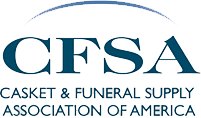An excerpt from Funeral Service Insider (FSI) – www.funeralserviceinsider.com
This year’s annual casket survey drew responses from 359 people – the most ever – which may just be one indication of how seriously funeral professionals are taking the need to properly price products and services as the national cremation rate continues to increase…
Presenting Caskets to Families
While 74 percent of respondents still have a full-size casket showroom, they’re presenting caskets to families in a variety of ways.
John Heald, an owner with Heald & Chiampa Funeral Home in Shrewsbury, Massachusetts, believes funeral directors should present caskets in whatever ways they are most comfortable with, but it’s a sign of how outdated many firms are when they’re not using flatscreen televisions, iPads and other tools that are readily available. “I still see showrooms merchandised by material type – copper, bronze, mahogany, etc. – and those that are theme based…”
How a funeral home presents caskets to families depends on a variety of factors, including the location of the meeting, the family’s preference and the arranger’s level of comfort with the tools, Troy Tuner, chief marketing officer of Batesville in Batesville, Indiana, says. “(These data) are consistent with our studies we’ve completed,” he says.
What the data to not show, however, is how effective the different tools are in helping families make informed decisions. “We know from our consumer research that selecting a casket is one of the most difficult and unfulfilling aspects of planning a loved one’s funeral,” Turner says. “The lack of knowledge about caskets in general, and not having a clear idea of what their loved one would want, make this decision more challenging. We believe the best solution for families is one that combines consumer-friendly, digital tools (that) are designed to educate and inform, with physical displays and supplemental printed materials that provide much-need context and allow families to make a personal connection.”
David Nixon, owner of Nixon Consulting in Chatham, Illinois, and a partner with Heartland Funeral Solutions in Springfield, Illinois, says it would be interesting to see if how funeral homes present caskets varies geographically. “I think what you’d find is that those on the West Coast … they really got away from selection rooms many years ago,” he says. “A lot of them have gone to catalogues and other methods because why devote space to a product that you sell so infrequently?”
Nixon says he’s a big believer in becoming comfortable with computerized displays because they’re portable. “You can take it to a home or you can talk to someone at the funeral home,” he says. “I’ve never seen that one method outperforms another. It’s all about what you show – that’s what it really comes down to.”
Bill Forsberg, chief operating officer and managing director of the funeral home group of the Lane Family of Companies in Ohio, says many funeral home owners that have gotten away from a full-size casket showroom would never return to it. “They have the metrics to show that higher average sales are achieved through alternative methods, with the electronic method the best,” he says.
More Insights on Casket Showrooms
While some operators and consultants have been advocating for replacing full-size casket showrooms with something that could generate more revenue – like a reception area for catered events where allowable by law – 74 percent of respondents still reported having a full-size casket selection room…
Even though the majority of respondents still have a full-size casket showroom, it’s worth noting that some have multiple locations – and they don’t necessarily have the full-sized models at every location. Moreover, 18 percent of respondents said that they were considering eliminating a full-size casket selection room at one or multiple locations – a significant number…
Those respondents who have a full-size casket selection room varied widely in the number of caskets they showed (as shown in the chart below).
Forsberg is a firm believer that it would be wise for funeral homes to be on the lower end of the range. “I don’t know about you, but my favorite restaurant shows 14 entrees in total – not 34,” he says. “Today’s consumer yearns for simplicity as life has become too complex in daily choices. It is a proven fact that an overabundance of choices drives the final decision to something based on frustration rather than fact if the features and benefits are not explained by a well-educated and confident professional.”
Kathy Williams and Melissa Drake, co-owners of American Funeral Consultants in New Paltz, New York, advise taking a “middle-of-the-road” approach in how many caskets are included in a full-size selection room. Think about showing 11 to 15 caskets, they say. “Of course, every funeral director must customize the selection room according to the practices of the community, but too many can be overwhelming and not enough can result in a feeling of dissatisfaction with the options,” they say. Eleven to fifteen caskets can provide a wide array of choices of wood and metal caskets while also covering a wide price range, they say.
Looking at the survey’s results, Turner says reports of the casket selection room being “dead” are clearly overblown. “Those who advocate getting rid of showrooms seem to focus on the short-term benefits of not having to carry inventory or the physical footprint,” he says. “But I haven’t seen any research to validate that getting rid of full-size products is the best long-term strategy for the funeral home. As I’ve said before, if we remove the physical products from the funeral home, we’re making it even easier for the entrepreneurs who are already setting up retail casket showrooms to fill that need with consumers.”
When a selection room is properly used, it can be great for business, Turner says. “I would suggest the question that deserves more attention is, ‘How do you optimize your selection room?’” he says. “We’ve conducted a number of studies this year to take a close look at that and understand the correlations between how products are displayed and presented in a room and the choices families make. The insights we’ve captured are very exciting, and we’re looking forward to sharing those in 2015.”
Patrick Cox, chief marketing officer at Matthews International in Pittsburgh, adds, “The best way to display a casket is dependent on a particular firm’s needs and available showroom space. We are seeing a trend in requests for more graphic and digital merchandising so that customers can free up some space for cremation merchandising of urns, keepsakes and other personalization offerings.”
Don’t be too eager to get rid of a casket selection room, Williams and Drake advise. “Many of the arrangers of funerals are of a generation that still has a traditional mindset and are not computer savvy,” they say. “These people expect to enter a room with a display of caskets that can be seen and felt.” They add, “As women, we understand the instinct of our gender to inspect merchandise tactually, and that can be a very important aspect of selecting a vessel in which to bury your loved one. Being able to run your hands over a casket and feel the finish and the interior to feel its softness is appealing to women who depend so much on their sense of touch. That being said, this can still be accomplished using quarter-cut casket samples, which take up a lot less space and can be less expensive in the long run.”



